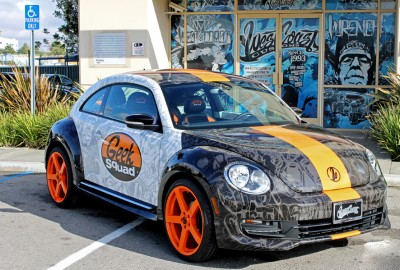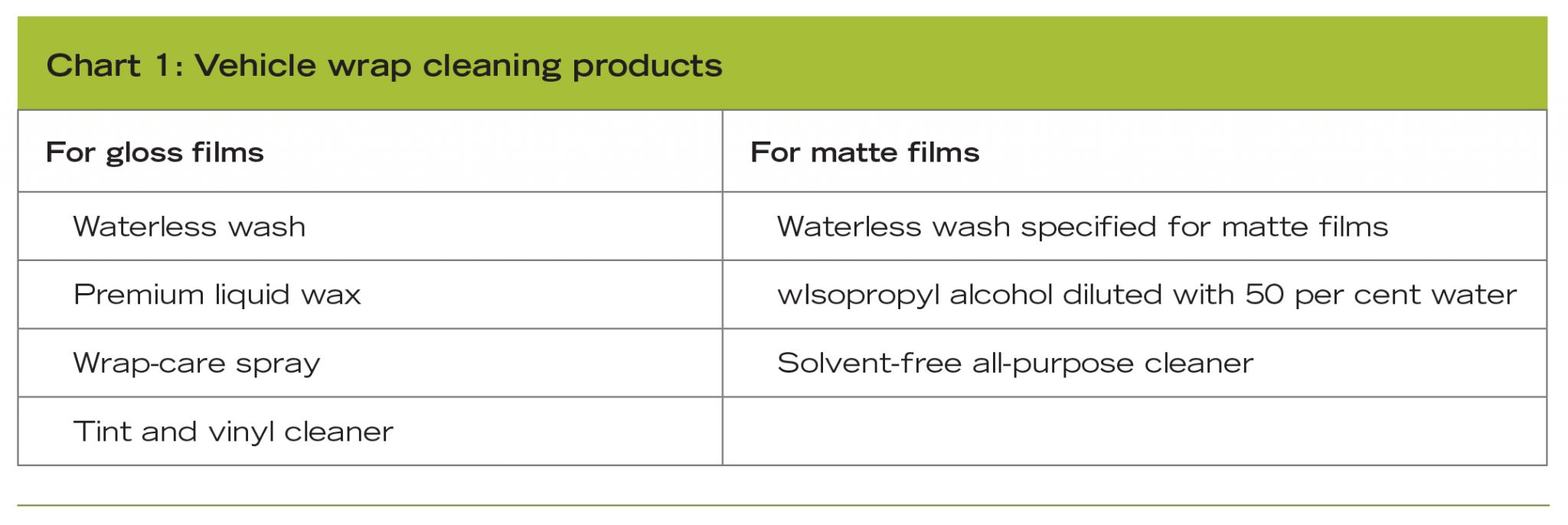Proper care and maintenance for vehicle wraps
by all | 26 February 2014 3:11 pm
 [1]
[1]Photos courtesy Avery Dennison Graphic Solutions
By Molly Waters
While many sign shops have entered the vehicle wrap market, where large-format graphic printing must be followed by skillful, specialized installation techniques, they often still have questions about how to clean and maintain a vehicle wrap for their customers. In this highly competitive field, it is very important to understand the benefits of cleaning vehicle wraps, so they can continue to stand out from the crowd with strong visual appeal.
Regular cleaning
A new car wrap should not be cleaned within the first 48 hours after installation, as that is how long the graphics will take before their adhesive achieves its maximum bond with the vehicle’s existing paint job. After those initial two days, however, the wrap should be cleaned at least once a month.
 [2]
[2]Applying an approved wax after cleaning will help boost UV protection, especially along horizontal surfaces.
It is surprisingly common to see or hear about car wraps not being cared for properly (or at all), even though they are being used to advertise high-profile businesses or to change the vehicle’s colour. Wrap shop owners speak of having to repair graphics after six months, only to find the grease pencil marks they used to align the graphics are still visible on the vehicle’s exterior. This is a very strong indication the owner or driver is not cleaning the wrap!
Not only will regular cleaning keep the wrap looking good longer, but it will also increase the advertising value for the business and, thus, the reputation of the sign shop that wrapped the vehicle in the first place.
A shaded area—preferably a garage—is highly recommended when cleaning a vehicle wrap. In the sunshine, it is easy to end up with more streaks.
Ensuring durability
In addition to looking good, regular cleaning can prolong the life of the graphics, especially in congested urban or industrial neighbourhoods and in high-elevation areas.
In the congested city areas, for example, high levels of smog, other pollutants and particulate matter in the atmosphere are problematic to the durability of a vehicle wrap, especially the horizontal surfaces (e.g. hood, roof and trunk). As chemicals become trapped on these areas of the material, they damage the wrap’s finish and increase its exposure to ultraviolet (UV) radiation from the sun, which will result in less durability for the graphics.
 [3]
[3]Various cleaning options are suitable for gloss and matte films, including those used in ‘paint replacement’ applications.
Similarly, at high elevations, such as in mountainous areas, the air is thinner than at sea level, so there is less filtering of UV radiation and, hence, greater exposure for vehicle graphics over time and greater damage.
Regular cleaning will remove the pollutants and particulates that can damage the graphics, while the application of an approved wax after cleaning will help boost UV protection, especially along horizontal surfaces of the vehicle.
With water
Vehicle graphics are printed onto self-adhesive films that can be damaged by strong cleaning agents, such as solvents. As these films vary in composition, a pre-cleaning test is highly recommended, preferably on an inconspicuous section of the vehicle, before beginning a complete cleaning treatment.
In fact, the best way to clean a vehicle wrap is fairly old-fashioned—by hand, with a mix of water and a mild detergent, using a soft cloth or sponge. The detergent should be a dedicated car-wash product, free of any abrasive components, strong solvents or alcohols, with a pH balance between three and 11.
Hand-washing a vehicle wrap is very similar to hand-washing a painted car:
- Pre-rinse. The first step is to rinse the vehicle with clean water, which will help both remove existing particles—e.g. grit—and prevent subsequent scratching.
- Wash. Gently agitate the soapy mild-detergent-and-water solution with a soft cloth or a synthetic or natural sponge, starting from the top of the vehicle and working down. Avoid unnecessary scrubbing, which could cause too much abrasion along the graphic film’s surface.
- Rinse. When finished washing with the solution, it is important to rinse the graphic again thoroughly with clean water.
- Dry. Allow the water to dry naturally or dab the surface dry with a chamois or a soft, non-abrasive towel, being careful not to lift any of the film edges.
While hand-washing is the preferred method, some vehicle owners will instead use a pressure washer, in which case they should follow these guidelines:
- Keep the water pressure below 8,274 kPa (1,200 psi).
- Keep the water temperature below 80 C (180 F).
- Keep the nozzle at least 305 mm (12 in.) away from the graphics’ edges.
- Keep the nozzle perpendicular (i.e. at 90 degrees) to the graphics. This will help avoid chipping or lifting the edges.
- Use a nozzle with a 40-degree wide angle spray pattern.
 [4]
[4] [5] If a vehicle wrap is cleaned in sunshine, it is easy to end up with streaks. A shaded area is recommended instead, preferably a garage.
[5] If a vehicle wrap is cleaned in sunshine, it is easy to end up with streaks. A shaded area is recommended instead, preferably a garage.
When using a pressure washer, any excessive pressure or spraying at the wrong angle can cause damage and create failure points in your graphics.
Driving the vehicle through a brushless automatic-spray car wash is acceptable if there is no other way to clean it, but the wax option should be skipped. It is important to avoid waxes that contain petroleum distillate, which can damage a wrap.
An automated brush wash must also be avoided. The brushes may catch the edges of the wrap’s panels or decals, creating new potential points of failure. They can even leave scratches in the graphics.
Without water
Another good option for cleaning a vehicle wrap is to use ‘waterless wash’ products. These can help improve or maintain the gloss level and performance of the film. In fact, if the vehicle is not overly dirty in the first place, a waterless wash may be the preferred option over hand-washing.
For vehicles that are very dirty, however, the best option is to hand-wash with water and detergent first, then apply a waterless wash for just the final touches.
If a waterless wash contains wax, it should not be used on a matte wrap, as it will fill in the texture and leave unwanted glossy, shiny spots. There are more suitable waterless washes for matte films, but a 50-50 mix of water and isopropyl alcohol will also work well to clean cars wrapped with these materials.
If the wax does not contain petroleum distillates, however, then its application is okay, and indeed, encouraged for glossy-finish wraps. Some waterless-wash-and-wax combinations are very good options, as long as the vehicle is not too dirty. As with detergents, it is a good idea to test any new waterless wash on an inconspicuous area of the vehicle before applying it to the entire exterior surface. [6]
[6]
Special situations
Some contaminants can be particularly difficult to remove, including tree sap, bird droppings and bug splatter. These should first be softened by soaking with hot, soapy water for several minutes, then rinsing thoroughly.
If a stronger chemical cleaner is needed, it too should first be tested in an inconspicuous area, to make sure it will not mar the wrap. And again, abrasive tools should be avoided, as they may scratch the graphics.
With the aforementioned matte films, some of the lighter colours, like ‘carbon fibre’ white, are more prone to showing dirt than others. If the mix of water and isopropyl alcohol does not cut the dirt, a hot soapy water solution—like that recommended for removing bird droppings and bug splatter—may be better at removing contaminants. Some all-purpose cleaners available at a local hardware store may also be effective.
 [7]
[7]An automated brush wash could leave scratches or catch the graphic panels’ edges.
Chart 1 outlines a variety of options for gloss and matte films, whether they are digitally printed or ‘paint replacement’ applications. Specific brands will need to be tested before full use, but checking the bottle should indicate whether they have been formulated for waterless wash, wax or waterless-wash-and-wax combinations.
Taking care
Another good way to extend the durability of a wrap is to store the vehicle in a garage and/or under a car cover whenever it is not in use.
In some cases, pollution and other damaging factors can cause a wrap to discolour or crack, at which point the graphics will need to be removed and replaced. And even though cleaning helps boost a wrap’s durability, it should not be assumed to outlast the film manufacturer’s suggested maximum period of use.
Molly Waters is a technical specialist at Avery Dennison Graphic Solutions, which provides imaging materials and services for fleet graphics and other markets. For more information, visit www.graphics.averydennison.com[8].
- [Image]: http://www.signmedia.ca/wp-content/uploads/2014/02/IMG_1811.jpg
- [Image]: http://www.signmedia.ca/wp-content/uploads/2014/02/IMG_0418-2.jpg
- [Image]: http://www.signmedia.ca/wp-content/uploads/2014/02/Avery-Dennison-Conform-Chrome-2.jpg
- [Image]: http://www.signmedia.ca/wp-content/uploads/2014/02/IMG_9472-2.jpg
- [Image]: http://www.signmedia.ca/wp-content/uploads/2014/02/Avery-Dennison-Conform-Chrome-2.jpg
- [Image]: http://www.signmedia.ca/wp-content/uploads/2014/02/SM_Feb_2014_HR-66.jpg
- [Image]: http://www.signmedia.ca/wp-content/uploads/2014/02/IMG_0727.jpg
- www.graphics.averydennison.com: http://www.graphics.averydennison.com
Source URL: https://www.signmedia.ca/proper-care-and-maintenance-for-vehicle-wraps/